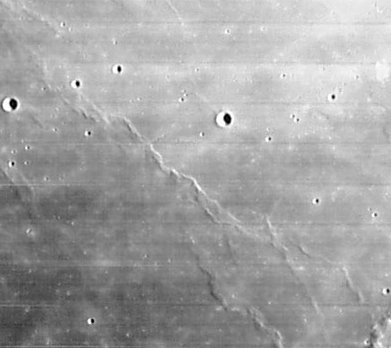Dorsa Whiston
Contents
Dorsa Whiston
|
Lat: 29.4°N, Long: 56.4°W, Length: 85 km, Height: km,[/R%C3%BCkl%2018 Rükl: 18] |
Table of Contents
[#Dorsa Whiston Dorsa Whiston]
[#Dorsa Whiston-Images Images]
[#Dorsa Whiston-Maps Maps]
[#Dorsa Whiston-Description Description]
[#Dorsa Whiston-Description: Wikipedia Description: Wikipedia]
[#Dorsa Whiston-Additional Information Additional Information]
[#Dorsa Whiston-Nomenclature Nomenclature]
[#Dorsa Whiston-LPOD Articles LPOD Articles]
[#Dorsa Whiston-Bibliography Bibliography]

LOIV-163-H1 The crater near the left-hand margin is [/Lichtenberg Lichtenberg] H, and the slightly larger one to the right of center from it is [/Humason Humason]. A small piece of [/Montes%20Agricola Montes Agricola] is visible in the extreme lower right corner of the frame. Dorsa Whiston is the ridge system that starts east of Lichtenberg H and runs towards Montes Agricola, forking just at the end. To the left (west) of the fork is the northern part of [/Dorsa%20Burnet Dorsa Burnet]. The stub of ridge crossing the left-hand margin just below Lichtenberg H is the southern tip of [/Dorsum%20Scilla Dorsum Scilla].
Images
LPOD Photo Gallery Lunar Orbiter Images
Dorsa Whiston was also photographed during the mission of Apollo 15, on color Hasselblad film, see AS15-97-13264 and 13265. Both orbital Hasselblad frames could be stitched together to create one single overview of the dorsa.
Research: Danny Caes
Maps
([/LAC%20zone LAC zone] 38B1) LAC map Geologic map LM map LTO map
Description
Description: Wikipedia
Additional Information
Nomenclature
- Named for William Whiston (December 9, 1667 - August 22, 1752), an English theologian, historian, astronomer and mathematician. He was an early advocate, along with Edmond Halley, of the periodicity of comets; he also held that comets were responsible for past catastrophes in earth's history. In 1701 he resigned his vicarship to become deputy at Cambridge to Sir Isaac Newton, whom two years later he succeeded as Lucasian professor of mathematics.
- Dorsa Whiston was among 120 names approved by the [/IAU IAU] in 1976 "as assigned" on the NASA [/LTO LTO] charts ([/IAU%20Transactions%20XVIB IAU Transactions XVIB]).
LPOD Articles
Bibliography
This page has been edited 1 times. The last modification was made by - tychocrater tychocrater on Jun 13, 2009 3:24 pm - afx3u2